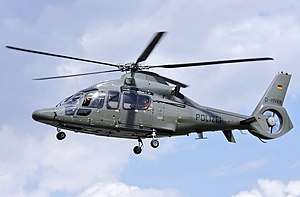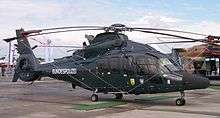Eurocopter EC155
The Eurocopter EC155 (now Airbus Helicopters H155) is a long-range medium-lift passenger transport helicopter developed by Eurocopter from its Dauphin family for civil aviation use. It is a twin-engined aircraft and can carry up to 13 passengers along with 1 or 2 crew, depending on customer configuration. The helicopter is marketed for passenger transport, offshore support, VIP corporate transport and casualty transport duties. In 2015, the EC155 was formally renamed to the H155, in line with Eurocopter's corporate rebranding as Airbus Helicopters.[1]
| EC155 H155 | |
|---|---|
 | |
| An Airbus Helicopters H155 with NRW Police (Germany) | |
| Role | Passenger transport helicopter |
| National origin | Multinational |
| Manufacturer | Eurocopter Airbus Helicopters |
| First flight | 17 June 1997 |
| Introduction | March 1999 |
| Status | Active |
| Produced | 1997-present |
| Unit cost |
US$10 million, €7.5 million |
| Developed from | Eurocopter AS365 Dauphin |
| Developed into | Eurocopter X³ |
Development
Originally designated AS365 N4, the EC155 was developed from the Eurocopter AS365 N3 Dauphin 2 with the aim of significantly increasing the cabin space of the Dauphin. Development began in September 1996 with the helicopter officially announced by Eurocopter at the Paris Air Show in June 1997. The first EC155 helicopter, a modified Dauphin airframe, made its maiden flight at Marignane on 17 June 1997 and the first pre-production EC155 B flew on 11 March 1998. The aircraft received safety certification by the French & German Civil Aviation Authorities on 11 December 1998 and went into production soon after, with a price tag of US$7–8 million depending on installed equipment.
In March 1999, deliveries of the EC155 B commenced, the German Federal Police became the first operator of the type. Between March 1999 and June 2003, roughly 50 EC155 Dauphins were sold, mainly to VIP and off-shore customers.[2]
The EC155 B1 was developed with uprated engines, giving it improved performance at high altitude and in hot temperature conditions; this derivative also features a higher maximum take-off weight (10,846 lb vs. 10,580 lb). Deliveries of this model began in November 2002 with the Hong Kong Government Flying Service becoming the first operator. In early 2003, Eurocopter completed studies for an even more powerful version of the EC155 B1, designed to better compete with new rotorcraft such as the AgustaWestland AW139 and to better meet military customer's requirements.[2]
Several major elements of the EC155, such its rotor system (albeit modified to operate at slower rotational speeds), were used in the Eurocopter X3, an experimental high-speed compound helicopter which set an unofficial speed record of 255 knots (293 mph; 472 km/h) in 2013.[3][4] In 2015, an EC155 was also used by Airbus Helicopters as a flying testbed for new aerodynamic features, such as the rotor blades, biplane stabilizer and canted fenestron, for the developing Airbus Helicopters H160 helicopter.[5]
In 2015, Airbus Helicopters and Korean Aerospace Industries (KAI) formed an agreement to transfer principle manufacturing activity for the EC155 to South Korea; KAI shall become the sole manufacturer of the type after 2018, and both firms shall be jointly involved in the international marketing and further development of the type. The EC155 is to serve as the basis for KAI's Light Civil Helicopter (LCH) and Light Armed Helicopter (LAH), featuring numerous changes including a new cockpit, improved gearbox and rotor blades; the LAH shall have a chin-mounted 20 mm cannon and side-mounted guided rockets, countermeasures systems, and be able to carry 6–10 combat troops. The LCH is to enter service in 2020, and the LAH will follow in 2022 to replace the MD 500 Defender and AH-1J/S Cobra. Airbus foresees a South Korean demand for 100 LCHs and 214 LAHs, and estimates an international market of 300–400 LAH versions to replace legacy attack helicopters.[6][7] Hanwha Techwin has been developing the TAipers (Tank Sniper) Light Armed Helicopter Air-to-Ground Missile (LAH-AGM) as the primary anti-tank missile for the LAH since 2015. Weighing 35 kg (77 lb) and guided by a dual CCD TV and imaging infrared (IIR) seeker delivering a fire-and-forget capability as well as a fire, observe, and update mode using a fiber-optic data-link, up to two twin-tube launchers can be outfitted on either side of the fuselage providing an anti-armor capability up to 8 kilometres (5.0 mi) away. Work is expected to be completed by the end of 2022 with serial production to commence in 2023, coinciding with the introduction of the LAH into ROK service.[8][9]
Design

The EC155 B features a completely redesigned cabin providing 30% more passenger space than previous Dauphin helicopter models, plus a 130% increase in baggage hold volume. Other major improvements include a five-blade Spheriflex composite main rotor combined with the familiar shrouded Fenestron tail rotor to reduce vibration levels significantly. The EC155 B is powered by two 635 kW (851 shp) Turbomeca Arriel 2C1 turboshaft engines mounted over the luggage hold, which feature a dual-channel Full Authority Digital Engine Control (FADEC) system. The EC155 B1 features uprated 697 kW (935 shp) Arriel 2C2s. The helicopter can be fitted with an anti-icing system to enable the aircraft to operate in very cold climates. The all-glass cockpit is equipped with an 'Avionique Nouvelle' integrated digital flight control system featuring Eurocopter's Vehicle and Engine Management Display (VEMD), which utilizes active matrix liquid crystal displays. The EC155 is also equipped with a four-axis digital autopilot, coupled to the engine FADECs for full-envelope protection, and is offered with a Health and Usage Monitoring System (HUMS).[10]
Eurocopter designed the EC155 originally with three configurations, however, another two configurations were added in 2005. The Passenger Transport version can carry 12 passengers in comfort seats or 13 passengers in utility seats, along with 1 or 2 crew. The VIP or Corporate Transport version has a VIP lounge with working space accommodating up to 8 executives. The Casualty Transport version can carry 2 stretchered patients with up to 4 seated medical staff, or 4 patients on stretchers plus 2 seated medical staff. The configurations added in 2005 were for Offshore operation and Police & Parapublic missions ranging from patrol, airborne surveillance, SAR and EMS, the helicopter being fitted with specific mission equipment for these duties.[11]
Variants
- EC155 – The first prototype, built from modifying an existing Dauphin airframe.
- EC155 B – The first production version, powered by two Turbomeca Arriel 2C1 turboshaft engines.
- EC155 B1 – An uprated model equipped with two Turbomeca Arriel 2C2 turboshaft engines and higher M.T.O.W., offering enhanced hot&high performance
- AS565 UC – Designation of early military derivative study
- LCH/LAH – Improved type develop by Korea Aerospace Industries. The LCH will enter service in 2020, and the LAH in 2022.[6][12]
Operators

The aircraft is operated by private individuals, companies and charter operators. It is also operated by government organisations and as an offshore transport for the gas and oil industry.
- Dominican Republic Air Force [15]
- Bundespolizei[16][17]
- NRW Police
.jpg)
- University of Michigan Survival Flight[21]
- University of Florida ShandsCair[22]
Specifications (EC155 B1)

Data from {Eurocopter.com}[23][24]
General characteristics
- Crew: 1 or 2 (pilots)
- Capacity: 13 passengers or 2,301 kg (5,073 lb) payload
- Length: 14.3 m (46 ft 11 in)
- Height: 4.35 m (14 ft 3 in)
- Empty weight: 2,618 kg (5,772 lb)
- Gross weight: 4,950 kg (10,913 lb)
- Max takeoff weight: 4,920 kg (10,847 lb)
- Powerplant: 2 × Turbomeca Arriel 2C2 turboshaft engines, Take-off Power, 697 kW (935 hp) each
- Main rotor diameter: 12.6 m (41 ft 4 in)
- Main rotor area: 124.7 m2 (1,342 sq ft)
Performance
- Never exceed speed: 324 km/h (201 mph, 175 kn)
- Range: 857 km (533 mi, 463 nmi)
- Ferry range: 985 km (612 mi, 532 nmi)
- Service ceiling: 4,572 m (15,000 ft)
- Rate of climb: 8.9 m/s (1,750 ft/min)
See also
Related development
- Aérospatiale SA 360 Dauphin
- Eurocopter AS365 Dauphin
- Eurocopter HH-65 Dolphin
- Eurocopter AS565 Panther
- Eurocopter X3
Aircraft of comparable role, configuration and era
Related lists
References
Citations
- "VIDEO: Meet the H Generation." Airbus Helicopters, 3 March 2015.
- "Eurocopter may power up EC155 to boost sales." Flight International, 2 June 2003. p. 6.
- Nelms, Douglas. "Aviation Week Flies Eurocopter's X3" Aviation Week & Space Technology, 9 July 2012. Accessed: 10 May 2014. Alternate link Archive
- Paur, Jason. "X3 Helicopter Sets Speed Record At Nearly 300 MPH" Wired, 11 June 2013. Accessed: 17 June 2014. Archived on 31 March 2014
- Osborne, Tony (3 March 2015). "Airbus Removes Veil From H160 Project". Aviation Week & Space Technology. Archived from the original on 4 March 2015. Retrieved 4 March 2015.
- Waldron, Greg. "PICTURES: KAI signs key LCH/LAH contracts." Flight International, 25 June 2015.
- Waldron, Greg."ADEX: Airbus Helicopters eyes international market for LAH." Flight International, 23 October 2015
- Wong, Kelvin (12 September 2016). "DX Korea 2016: Hanwha unveils 'Tank Sniper' guided air-to-surface missile for future South Korean army helo programme". Jane's Information Group. Retrieved 6 November 2016.
- Hanwha's TAipers ATGM completed Critical Design Review – Airrecognition.com, 19 October 2017
- Gray 2000, pp. 48–49.
- Gray 2000, p. 48.
- Waldron, Greg. "Airbus Helicopters to work with KAI on LCH/LAH programme." Flight International, 16 March 2015.
- "Shanghai targets city fleet of 15 helicopters by 2020". helihub.com. Retrieved 10 March 2013.
- "Eurocopter EC-155B Aircraft". Copyright 2012 Demand Media, Inc. Retrieved 3 December 2013.
- "– FAD 01: historia de la flota aerea presidencial dominicana (in Spanish)". Archived from the original on 7 November 2017. Retrieved 21 April 2017.
- "Last two of twenty EC155s handed over to German Federal Police". helihub.com. Retrieved 10 March 2013.
- "Eurocopter EC-155B Aircraft". Copyright 2012 Demand Media, Inc. Retrieved 3 December 2013.
- "Eurocopter EC 155". aerospace-technology.com. Retrieved 10 March 2013.
- "Hong Kong Government Flying Service EC155". Demand media. Retrieved 10 March 2013.
- "Royal Thai Police takes delivery of three EC155s". helihub.com. Retrieved 10 March 2013.
- "University of Michigan's 3 EC155s set new standards". propilotmag.com. Archived from the original on 1 March 2014. Retrieved 25 February 2014.
- "UF Health Unveils Advanced ShandsCair Helicopter". mygtn.com. Archived from the original on 5 July 2015. Retrieved 3 July 2015.
- "EC155B1". France: eurocopter.com. Archived from the original on 18 April 2012. Retrieved 21 April 2012.
- Nicolas. "Airbus Helicopters, Inc. - H155 (formerly known as EC155) specifications". airbushelicoptersinc.com. Archived from the original on 14 July 2014. Retrieved 17 June 2014.
Bibliography
- Gray, Peter. Dauphin "Bigger and Better." Flight International, January 2000. pp. 48–51.
External links
| Wikimedia Commons has media related to Airbus Helicopters H155 Dauphin. |